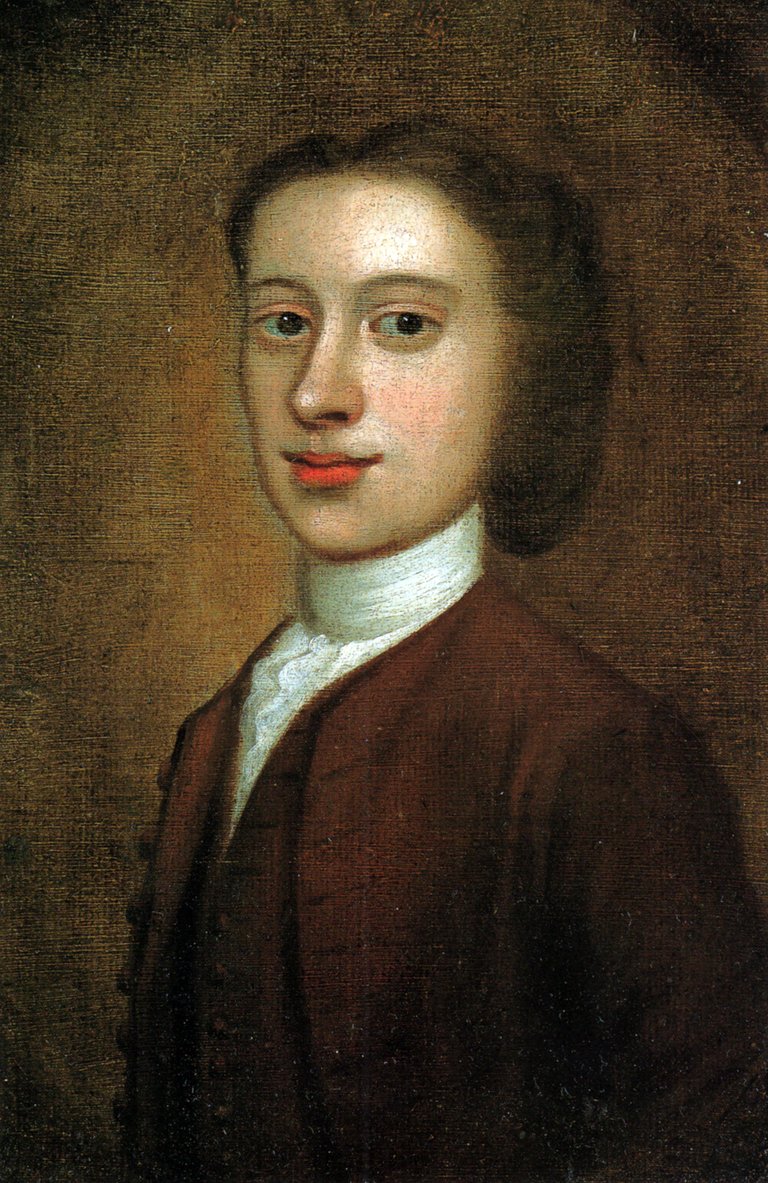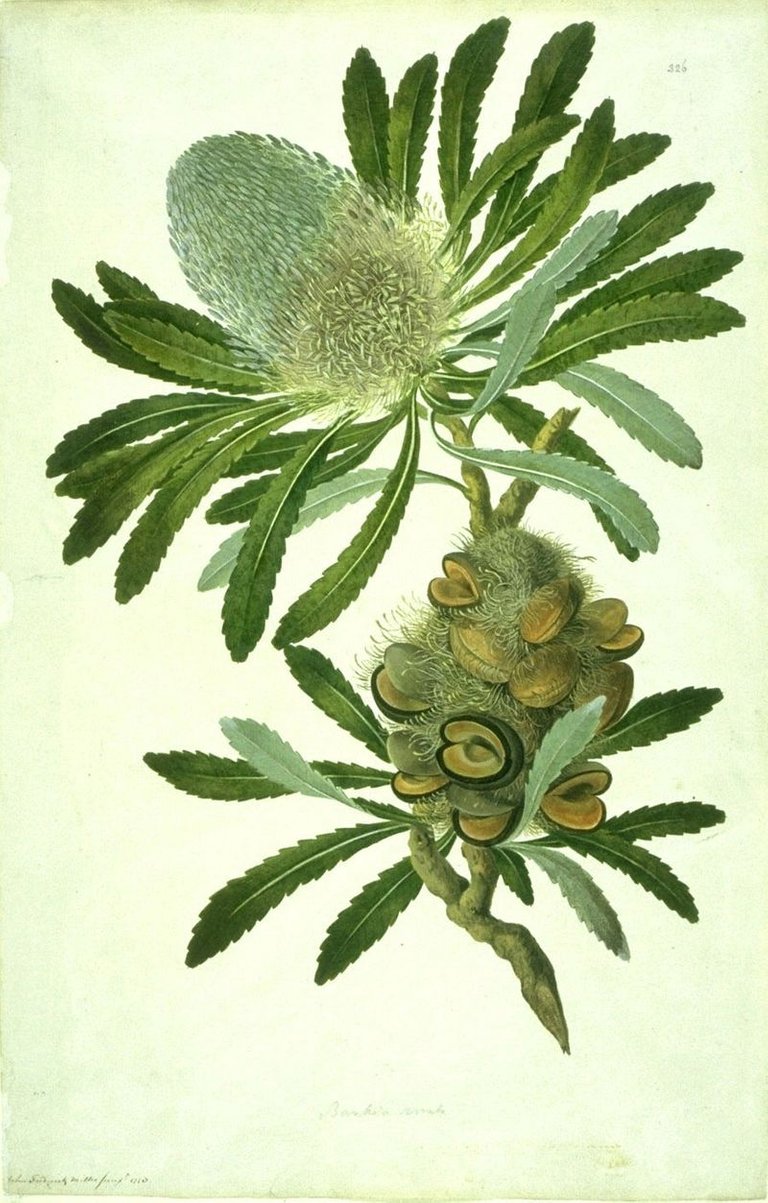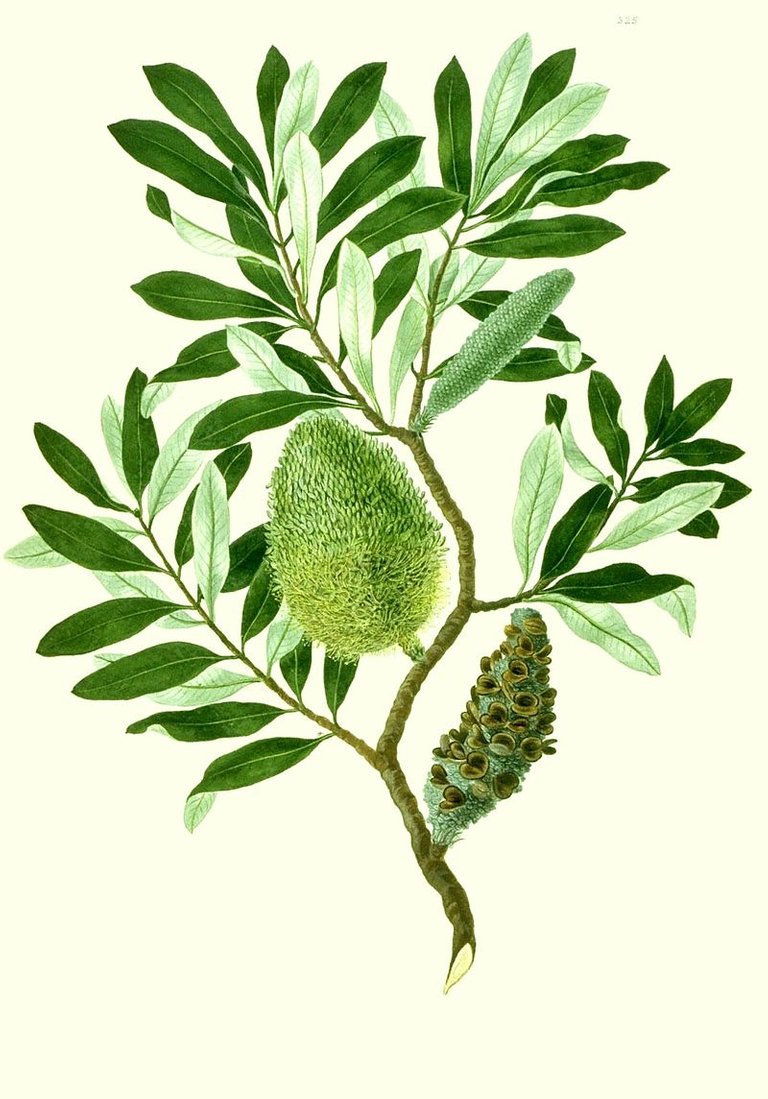I would like to begin a series of articles that recognize great botanical illustrators of the past. These were artistic pioneers of science illustration, capturing the diversity and beauty of plants before photography was routinely available. These are often unsung heroes of scientific inquiry and discovery. Examples of some of their artistic work available in the public domain will be included.
The focus of this article is on Sydney Parkinson, who was the botanical artist who sailed on the HMS Endeavour in 1768 with Captain Cook, to South America, Tahiti, New Zealand and Australia. His biography is pieced together from the articles listed below in the reference section.

Sydney Parkinson - self-portrait. Image source: (1)
Sydney Parkinson was born in Edinburgh Scotland in 1745 (exact date unknown (3)). He was the son of Joel and Elizabeth Parkinson. Joel Parkinson was a Quaker brewer in Edinburgh (5), and both Joel and Elizabeth were members of the "Edinburgh Meeting" (a Quaker meeting house), which included Dr. John Fothergill, who had established a botanical garden at Upton Park in Essex (5). Fothergill in turn was a friend of James Lee who (together with Lewis Kennedy) had established a nursery, "The Vineyard", in London (5). It was Lee who introduced the young (22 year-old) Sydney Parkinson to Joseph Banks, a wealthy British naturalist and explorer, in 1767 (4, 5). Sydney Parkinson had moved to London in 1766 to improve his education and experience (2, 3). He spent many days sketching plants at James Lee's "The Vineyard" (3, 4) in London and exhibited some flower paintings in London (2). His skills soon caught the attention of James Lee and Joseph Banks, who hired Parkinson to draw plants at the botanical garden at Kew in 1767 (2). It is speculated that Sydney Parkinson had learned his artistic skills and draughtsmanship from William de la Cour, a gifted French artist in Edinburgh (2, 3, 5).
Sydney Parkinson was soon hired by Joseph Banks to travel with him on James Cook's first voyage to the Pacific and to serve as artist (botanical draughtsman) on the expedition (2, 5). Alexander Buchan was hired as a topographical draughtsman (2). The stated reason for the Endeavour expedition was to observe the transit of Venus at Tahiti, but it was speculated that Captain Cook had additional secret instructions to explore the regions around Australia and New Zealand (5). It is estimated that Joseph Banks spent approximately £10,000 to ensure a place on the Endeavour for himself and his 13 assistants (including Parkinson). It would be the naturalist's discoveries for which the voyage would became famous (5).
Endeavour set sail on the 26th of August 1768. From England Cook sailed to Madeira and then to Brazil (6). The Endeavour entered the Pacific at the end of January 1769 and continued to Tahiti (referred to by Sydney Parkinson as Otaheite) where Banks's other artist, Alexander Buchan, died, thus greatly increasing Parkinson's workload (5). Apparently Alexander Buchan, the landscape painter, suffered a severe epileptic fit, fell into a coma, and died (3):
15-19 April, 1769. "Mr. Buchan was seized with an epileptic fit this morning, and remained insensible all day." "On the 17th, early in the morning, Mr. Buchan died, and we went out in the pinnace and long boat to the offing, and buried him." From: Parkinson's Journal p. 38 (10)
On the ocean, Joseph Banks and his assistant Dr. Daniel Solander (a close associate and ex-pupil of Carl Linnaeus; the grandfather of modern botany (7)), collected everything the dragnets dredged up, leaving the myriad assorted creatures and seaweeds for Parkinson to draw (3). On land they would collect numerous plant and animal specimens. However, there were surprisingly few new plant species to document until the expedition reached Australia (3).
When the expedition moved on to Australia, the changes could not have been more dramatic. The people, the animals, and the plants all appeared to be worlds apart from anyone or anything they had encountered before. True to their botanical leanings, Banks and Solander collected mostly botanical specimens, with only a few examples of the local birds and mammals and sea creatures - and Parkinson was expected to draw them all. He was inundated, and worked hard to keep up with the huge number of plants being brought onboard the Endeavour each day, often making only sketches of each item, with hastily scribbled notes about the colours he would fill in later (3).
The expedition spent several months off the coast of Australia (3). Banks and Solander collected over 1,000 species of plants new to science (3). Sydney Parkinson made over 1,000 drawings of plants and animals collected by Banks and Solander (280 finished and botanically accurate paintings and over 900 sketches and drawings (3)). Among these were 4 species of Banksia collected by Joseph Banks in 1770 in Botany Bay, 2 of which are illustrated below:

Banksia serrata is named after Joseph Banks. This is a watercolour-on-paper drawing of Banksia serrata. The attributed artist is John Frederick Miller, but the work would have been heavily based on a partially coloured sketch by Sydney Parkinson, Sir Joseph Banks' botanical artist who was present when the species was first collected at Botany Bay, Australia.

Banksia integrifolia is named after Joseph Banks. This is a watercolour-on-paper drawing of Banksia integrifolia. It was drawn and at least partly coloured by Sydney Parkinson, Sir Joseph Banks' botanical artist who was present when the species was first collected at Botany Bay, Australia. It is not known whether the drawing was completed by Parkinson, or whether it was delivered unfinished for completion by one of the London artists employed by Banks for that purpose.
The reader is encouraged to search the "The Endeavour Botanical Illustrations (Natural History Museum)" (14) for other images created in large part by Sydney Parkinson, and/or search "Natural History Museum Images" using the search term "Sydney Parkinson" (13) to see the full scope of his work.
When the Endeavour struck the Great Barrier Reef in Australia, and was damaged, the ship set sail to Batavia (present-day Jakarta) for repairs. This ten-week stopover in Batavia proved fateful for Parkinson (5).
Until they landed at Batavia, Cook's men had been healthy, being fed fresh foods whenever in port and kept clean, dry and warm on board. Nobody had counted on 'Batavia fever', a term for the effects of malaria and dysentery contracted from the city's numerous dirty canals. By the time the Endeavour reached the Cape of Good Hope in 1771, almost a third of the men had died. Among the first was Parkinson, aged just 26 (5).
On the return trip the ship Endeavour was besieged by illness and Sydney Parkinson contracted dysentary at Princes Island, on the way to Cape Town. He died on January 26th 1771 and was buried at sea (2).
Sydney Parkinson's journal is now available in print (8) and online (10). His last entry is dated 16th January 1771 (page 249) (10). It is then continued by other members of the expedition:
On the 16th of January, we took our departure from this island; and, a few days after, the disorder with which several of our company had been attacked, and died at Batavia and Coopers Island, began to rage among us with great violence, and, in a few days, carried off Mr. Charles Green, the astronomer; Mr. Sydney Parkinson, Mr. David Spoving, clerk to Mr. Banks, and many of the common men. Mr. Green, being early seized with a delirium, unfortunately left some of his minutes so loose and incorrect, that it is feared it will be difficult to render them intelligible. (p. 250) (10).
Upon the return to England, Banks paid Sydney Parkinson's outstanding salary to his brother, Stanfield Parkinson, and eventually secured ownership of his sketches and paintings (2, 3). Banks then authorized completion of Sydney Parkinson's partially coloured sketches by other artists, including John Frederick Miller.
Surprisingly the full collection of botanical prints was not published until November 2017: "Joseph Banks' Florilegium: Botanical Treasures from Cook's First Voyage", by Mel Gooding, David Mabberley and Joe Studholme (11).
This is the first full-colour publication of some of the most extraordinary botanical prints of the 18th century. Banks’ Florilegium is not only a great scientific record, but also a major achievement of collaborative Enlightenment art, and a work of botanical illustration of outstanding beauty (11).
Connor Yearsley (12) has written a wonderful article about this book and provides many more details about Endeavour's voyage, return to England, and how the Florilegium was eventually put together. Yearsley also provides numerous illustrations from the Florilegium (12). For further details of this voyage and its impact on science and art, please also consult the book entitled "Sydney Parkinson : artist of Cook's Endeavour voyage", by D.J. Carr (1983) (Australian National University Press) (9), and the books listed at the end of the BBC article on Endeavour's Scientific Impact (1768 - 1771), by Steve Cafferty (7).
Despite Parkinson's huge impact on the collection and catalogueing of many plant species new to science, only one plant now bears his name, Ficus parkinsonii (5, 15).
References:
Sydney Parkinson (1745 - 1771) - the botanical artist on the Endeavour (Botanical Art and Artists).
Sydney Parkinson b. c. 1745 (Design & Art Australia Online).
The Endeavour botanical illustrations (Natural History Museum).
Endeavour's Scientific Impact (1768 - 1771). By Steve Cafferty. Last updated 2011-02-17 (BBC).
Natural History Images: Sydney Parkinson (Natural History Museum.
The Endeavour Botanical Illustrations: Search Images (Natural History Museum)
Historical botanical illustration of the day: Ficus parkinsonii.
Footnote:
Scientific botanical illustration has a long and illustrious history (see: The History of Botanical Art and Illustration). But it has not been totally replaced by photography! It remains a vibrant, contemporary activity (see: Contemporary botanical artists and illustrators around the world), with many artists being women!
"Botanical illustration is the most popular genre of natural history illustration. Many botanical artists still work within the traditional sphere, illustrating scientific journals and popular literature, but a number have crossed over into the fields of fashion and design, which continue to draw inspiration from natural patterns and images". From: The modern botanical illustration collection
Excellent guides on scientific botanical illustration are now available (see: Scientific Botanical Illustration: How to draw plants to scientific standards).
For those steemians with an artistic passion, please take a look at this announcement regarding the interface between art and science, technology, engineering and mathematics (#steemstem): Announcing STEM-Art: An Open Access Image Commission Project! A picture is worth a thousand words!
This post has been voted on by the SteemSTEM curation team and voting trail in collaboration with @utopian-io and @curie.
If you appreciate the work we are doing then consider voting all three projects for witness by selecting stem.witness, utopian-io and curie!
For additional information please join us on the SteemSTEM discord and to get to know the rest of the community!
Thank you!
Hi @davidrhodes124!
Your post was upvoted by Utopian.io in cooperation with @steemstem - supporting knowledge, innovation and technological advancement on the Steem Blockchain.
Contribute to Open Source with utopian.io
Learn how to contribute on our website and join the new open source economy.
Want to chat? Join the Utopian Community on Discord https://discord.gg/h52nFrV
Fascinating biographical essay
Thank you!
A dangerous job back in the day!
Yes indeed!
'Good God. When I consider the melancholy fate of so many of botany's votaries, I am tempted to ask whether men are in their right mind who so desperately risk life and everything else through the love of collecting' plants.'
Carl Linnaeus, Glory of the Scientist (1737)
https://www.plantexplorers.com/explorers/index.html
That sums it up. Although life was also generally much more nasty, brutal and short for everyone
Nice post, and thanks for the leads/links in the footnotes.
Cheers!
Golden age of explorations and amazing blend of adventure, science and art.
I have often wondered what it would have been like to be living back then. Life expectancy was pretty poor, but certain individuals seemed to be able to pack a lot of living and accomplishment into a few short years.
What I'm missing is the feeling that we possess enough skills/knowledge to handle tasks.
It's a good feeling when you know how to produce food, how to build tools, how to repair machines and buildings.
I used to have that feeling while I was younger as my country was lagging behind for about 50 years.
A simple sense of competence, sustainability and accomplisment.
Today, in everyday life (and especially in academia), I feel that I'm powerless. Feeling that I'm nothing but a small bolt embedded into the giant machine.
I never feel that I know enough. I know that I can't do anything from start to finish and there is no real accomplishment.
The world itself also became too uniform. The same food, clothes, customs... There is almost nothing to spark our imagination and desire to travel and explore.
It would be fantastic to experience what those generations from the XVIII and XIX century experienced.
Awesome comment. Thanks. We are all much more specialized these days. Collaboration helps overcome the feeling of not knowing enough. Your observation that many of us do not know how to produce food, repair machinery, build tools etc is very much appreciated. This is something that I am also concerned about for the future of humanity if, for example, a cataclysm occurred. The explorers and discoveres of the 1700's would be much better prepared.
Congratulations @davidrhodes124! You have completed the following achievement on the Steem blockchain and have been rewarded with new badge(s) :
Click here to view your Board
If you no longer want to receive notifications, reply to this comment with the word
STOPDo not miss the last post from @steemitboard: